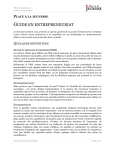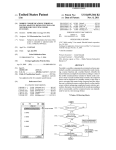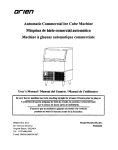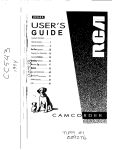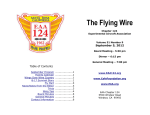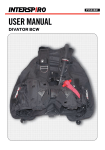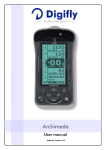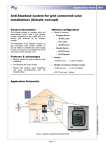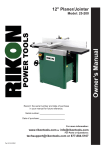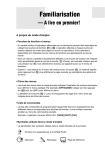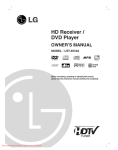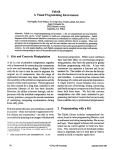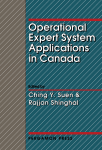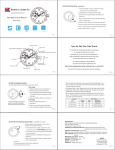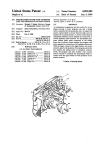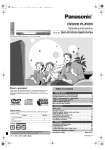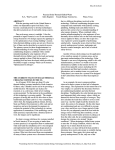Download Depth finder with tutorial
Transcript
United States Patent [191 Leavell et a1. ' [54] DEPTH FINDER WITH TUTORIAL [75] Inventors: David R. Leavell, Columbus, Ga; Earl W. Spencer, Jr., Montgomery, Ala.; Bruce L. Bacon, Columbus, Ga. [73] Assignee: Microsonics, Inc., Columbus, Ga. [21] Appl. No.: 380,796 [22] Filed: [11] [45] 4,943,951 Jul. 24, 1990 Bass Pro Shops, 1988 Catalog; pp. 438-450. The Bottom Line User Manual; 1986; pp. l-l8. Primary Examiner—Thomas _H. Tarcza Assistant Examiner-Tod Swann - Attorney, Agent, or Firm—Jennings, Carter, Thompson & Veal [57] Jul. 17, 1989 Patent Number: Date of Patent: ABSTRACT A liquid crystal display depth ?nder using a sonar trans ducer is provided with a plurality of input keys inter faced to a microprocessor with each input key being [51] Int. c1; ............................................ .. G01S 15/96 [52] U.S. c1. .................................. .. 367/111; 367/107; [58] Field of Search ............... .. 367/99, 107, 111, 112, dedicated to a particular function or feature usable with [56] 367/115, 910; 434/1, 6, 10 References Cited trol the operation of the transducer and the display of the data generated thereby in accordance with the par 367/910; 434/6 . U.S. PATENT DOCUMENTS 4,597,069 6/1986 Milano et a1. ................. .. 367/112 X OTHER PUBLICATIONS Eagle 3D-l00, Liquid Crystal Graph; Dec. 1987, pp. 142; Owners Manual. the depth ?nder. The microprocessor is utilized to con ticular function or set of functions chosen by the opera tor and to manipulate programming stored within the depth ?nder which will enable a tutorial mode compris ing alphanumeric information and command key indica tion such that an the user may determine how the ma chine is to properly function. Eagle 7-7500; Cabela’s, 1987, Christmas Catalog, 1 page. 10 Claims, 6 Drawing Sheets US. Patent Jul. 24, 1990 Sheet 1 of 6 4,943,951 I Z ?vowER DISPLAY LIGHTS 1' : ON/OFF r '- FISH RATE ON/OFF ;' RANGING 200M1 3'; '27 Zle Aura/Mm ~4. "t%€%% 239 saws 21h +18%“ j I_ ALARM L AUTOIMAN TIME/ALARM sew " US. Patent Jul. 24, 1990 Sheet 2 of 6 4,943,951 \NITIALIZE & SHOW LO GON 1 5E ARCH FOR BOTTOM II SOUND FOR DBPLAY SEARCH FOR BOTTOM SOUND FOR DISPLAY FlLTER I TRACK DATA BOTTOM V A B L A CK BELOW BOTTOM ‘ ADJUST RANGE SCALE. l A US. Patent Jul. 24, 1990 Sheet 3 of 6 l Fig. 2B ERASE SHALLOW CLUTTER BOTTOM TRACKED > 3x ? PREPARE SOUNDTNG FOR SCREEN l CHECK FISH ALARM l SCROLL D\SPLAY SCREEN l DTSDLAY BOTTOM SEGMENT PUT UP SMALL BOX MESSAGE l STORE SOUNDTNG DATA 1 BUZZER OFF D\SPLAY TIME l DTSPLAY TOP UNE SCROLUNG l CHECK BOTTOM ALARM i \F DEMO GET DEMO BOTTOM l LOOK AT KEY PAD & D\ S P LAY OMALL BOX MESSAGE 4,943,951 US. Patent Jul. 24, 1990 Fig. 3 Sheet 4 of 6 START DEMO OPEN IN G MODE. MESSAGES V H IT KEY FEATURE PROMPT CASE! A KEY IS HIT I ARROW KEY FEATURE KEY POWER KEY SPECIFY FIRST PAGE TO BE SHOWN V SHOW SPECIFIED PAGE OF TH IS FEATURE UDISPLAY ASSIGNED ANIMATION CASEI WAIT ON A KEY TO BE HIT DIFFERENT FEATURE KEY SAME FECAIQ'URE KEY DOWN ARROW ADVANCE TO NEXT PAGE A BACK UP TO PREVIOUS PAGE 4,943,951 US. Patent Jul. 24, 1990 Fig. [I- Sheet 5 of 6 4,943,951 Power Supply 26 ) Keypad 28 A 13 Display ~f Microprocessor . E P R0 M Receiver ° Transmi’r’rer 31~ Temp. Sensor l Transducer :i \,I\/ 29 US. Patent Jul. 24, 1990 E Sheet 6 of 6 1 4,943,951 A . > W USER GUIDEI ‘2 WELCOME TO I E FOR = HAWKEYE'S :1 = PRESS ANY = E: USER'S : : FEATURE KEY = GUIDE 3 C USE 3 DEMO 3 : POWER E C AND . L ' TO S |NF0 g A Fig. 5 Fig. 6 ALARMI 3 PRESS KEY ONCE TO ': TURN THE 2 : FISH ALARM :1 EITHER ON OR OFF Fig. 7 I, EXIT L ‘FISH KEY 2” 1 4,943,951 2 may be ascertained. The depth finder may also have a DEPTH FINDER WITH TUTORIAL variety of sensitivity selections or functions which the operator needs to learn. Many of these functions have FIELD OF THE INVENTION been enabled by the utilization of chip technology with small computers which are actually employed in the circuitry of the depth ?nders. Therefore, it is not un The present invention relates to depth ?nders and more particularly to depth ?nders which use acoustic waves generated by a transducer mounted on a boat to common for the ?sherman to be overmatched when determine the depth and bottom contour of a body of water and also to locate ?sh suspended in the body of water. More particularly the present invention relates ‘to a depth ?nder of the type utilized by sport ?shermen and in even greater particularity relates to a depth ?nder wherein the acoustic data retrieved by the system dealing with his particular depth ?nder, that is to say, is displayed on a pictorial screen such as may be gener ated by the use of a Liquid Crystal Display (LCD). In even greater particularity the present invention may be the ?sherman may have more equipment than he is able to handle while maintaining an interest in catching a ?sh. To this end, it has become apparent that the techni cal aspects of using a depth ?nder with its various sensi tivity and automation features has reached the level where a need exists for a simpli?ed depth ?nder which can perform all of the functions that a ?sherman wishes to have performed. described as a depth ?nder of the aforementioned type wherein a tutorial mode is employed to provide an on-screen alpha-numeric description and feature illus tration presentation which allows the user to obtain assistance in the proper utilization of the depth ?nder. BACKGROUND OF THE INVENTION Over the past several years the utilization of depth ?nders in locating schools of ?sh and bottom structure has become an increasingly popular adjunct to sport ?shing. The early depth ?nders were based on the World War II era sonar which allowed an acoustic signal to be generated and transmitted through the wa ter, re?ected by the bottom and returned to a sensing device which, in combination with electronic circuitry, was able to time the transit of the wave through the water and judge the distance of the bottom from the boat. Oftentimes these devices merely presented an indication on a circular scale that stated that the bottom was at thus and such depth and therefore it was neces sary to pay close attention to the scale to determine contour of the bottom of the body of water. As these devices have progressed over the years, the state of the art has developed to the point that it is common to employ a recorded graph which automatically traces a pictorial representation of the bottom of the body of water on a strip of paper using pins or other imaging techniques with the strip of paper being retained by the SUMMARY OF THE INVENTION It is an object of the present invention to provide a depth ?nder which will enable the sport ?sherman to easily locate bottom features and suspended ?sh while ?shing. Yet another object of the invention is to provide a depth ?nder of the above type which is user friendly in 25 that it will be able to assist the ?sherman in the opera tion of the depth ?nder. Yet another object of the invention is to provide a depth ?nder which can be used as a training device so that the ?sherman may become acquainted with its various features prior to having to actually use the depth ?nder on a body of water as well as on the water. Yet another object of the invention is to provide a depth ?nder which contains a built-in tutorial mode such that the depth ?nder may teach the ?sherman how to use the depth ?nder providing written instruction for display on the depth ?nder along with indication illus trations for each command key. Accordingly, these and other objects and features of my invention are provided in a novel combination of technology and ingenuity wherein a liquid crystal dis play depth ?nder using a sonar transducer is provided with a plurality of input keys interfaced to a micro processor with each input key being dedicated to a operator. In these instances, of course, a permanent 45 particular function or feature usable with the depth ?nder. The microprocessor is utilized to control the record of the bottom contour along a particular transit operation of the transducer and the display of the data line across the water may be recorded and preserved. It generated thereby in accordance with the particular will be appreciated that most ?shermen do not have a function or set of functions chosen by the operator and need to record each transit of the body of water but to manipulate programming stored within the depth rather are more particularly concerned with the sub ?nder which will enable a tutorial mode such that in merged features of the body of water as they are mov struction may be obtained by the user on the use of any ing over the body of water. This is particularly true in of the features enabled by the control keys an so that he as much as the sensitivity of depth ?nders has been may determine how the machine is to properly func increased to the point where suspended objects such as tion. The depth ?nder has a standard operational mode ?sh or schools of ?sh may be detected by the depth wherein it is capable of providing such information as a ?nders and represented on a display screen. Therefore it ?sh alarm which provides an audible alert when ?sh are is now popular to provide depth ?nders which have detected, manual or automatic ranging to adjust the display screens such as liquid crystal displays which can depth scale, selective monitoring of a speci?ed depth of give a pictorial representation of not only the bottom of the body of water but also of ?sh suspended above the 60 water or of a speci?ed region of water proximal the bottom, manual or automatic sensitivity adjustment, bottom of the body of water. illumination of the keypad, surface temperature, and the The evolution of the technology has seen a corre sponding evolution of the complexity of the data and time and date. The display rate may also be varied, thus information required by the ?shermen. As the technol it may be seen that the depth ?nder is a somewhat com ogy has grown, the ?shermen has been required to plicated instrument. Accordingly, our invention utilizes become increasingly adept at operating the depth the same input function keys and the control keys which ?nder. For example, the depth ?nder may have a plural are utilized to control each of the above described func ity of ranges over which the depth of the body of water tions of the depth ?nder in a tutorial or demonstration 3 4,943,951 mode, thereby allowing the ?sherman to utilize the depth ?nder as a an instructional training device. To accomplish this aspect of the invention, we have pro vided a memory programmed to generate an arti?cial display on the screen which display can be controlled by utilization of the function keys on the depth ?nder. Associated with each function key on the depth ?nder and the display is information presented in graphic form which provides a textual explanation of the utilization of the particular function key. Thus the operator may at 4 tation covers the entire depth of water and illustrates what that depth may be or may indicate that the picto rial representation covers only a selected depth of water and indicates what that depth of water may be. Also displayed on the liquid crystal display 13 imme - any time place the depth ?nder in the demonstration or diately below the range numeric indicators 16 is a digi tal bottom indicator which digitally represents the depth of the bottom as determined by the depth ?nder at any particular moment. The display 13 may also indicate on its face a variable temperature display 18 which provides a Fahrenheit indication of the tempera tutorial mode and obtain assistance in utilizing the par ticular function key while either on the lake or other ture of the water at the transducer and a clock display 19 which provides the current time. Of course the dis body of water or at home or on dry land. Thus the ?sherman has no need to fumble with an instruction manual which may become soiled, Wet or lost while he is trying to operate his depth ?nder and catch ?sh. Therefore the inherent frustration which accompanies play would not be complete without a graph representa tion 21 of the bottom 22 of the body of water and any objects 23 which may be suspended above the bottom 22. Preferentially across the top of the display above the graph 21 is provided a plurality of function indicators the use of a technical device in what should be a relax 24 which inform the operator at a glance as to which ing setting is overcome by a very simple innovation which takes the guesswork and confusion out of operat functions are being utilized in generating the current display. The housing also includes a keypad indicated ing a sophisticated depth ?nder. generally at 26 which allows the operator to control the functions of the depth ?nder or to select automatic BRIEF DESCRIPTION OF THE DRAWINGS operation of the depth ?nder. The keypad includes a Apparatus embodying features of my invention are 25 plurality of individual keys 27, each of which is associ depicted in the accompanying drawings which form a ated with a particular function of the depth ?nder or a portion of this invention and wherein: particular control command to the depth ?nder. By FIG. 1 is a pictorial representation of a depth ?nder way of example, in the illustration it may be seen that embodying my invention showing the display face and there are three keys 27 indicated across the upper right input keyboard of the depth ?nder; . 30 portion of the depth ?nder. These keys correspond to a FIGS. 20 & 2b are a simpli?ed version of a flow chart power on/off key 27a, a display rate key 27b and a light depicting the operation of the depth ?nder; on/off key 270. The lower nine keys 27d-k provide FIG. 3 is a simpli?ed version of a ?ow chart showing input from the operator to the depth ?nder as to such features as the ?sh alarm, the ranging, bottom tracking, mode; 35 bottom alarm, sensitivity, the clock and controls such as FIG. 4 is a simpli?ed block diagram of the electronic increasing or decreasing any of the foregoing. As may circuitry which may be used in my depth ?nder; and be seen in FIG. 4, a microprocessor 28 operatively FIGS. 5-7 are pictorial representations of the display connected to the keypad 26 controls the display 13 and while in a tutorial mode. receives input not only from the keypad 26 but also from a transducer 29 and a temperature sensor 31. DESCRIPTION OF A PREFERRED The microprocessor 28 has associated therewith vari EMBODIMENT ous memory or storage devices which allowed the pro Referring to FIG. 1, it may be seen that my depth cessor to access a set of commands to control its opera ?nder includes a housing 11 which encases the elec tion. Thus, in FIG. 2 the microprocessor 28 will per tronic circuitry generally depicted in FIG. 4. The hous 45 form a plurality of steps and poll each of its inputs in a . ing 11 has attached thereto a set of mounting and adjust speci?ed order. The preferred order, as shown in FIGS. ment knobs which allow the depth ?nder to be mounted 2a and b is to initialize all parameters in accordance the operation of the depth ?nder when in the tutorial to the boat in a conventional manner and oriented as is convenient for the ?sherman to observe the pictorial with a predetermined set of conditions and then begin a bottom search. As may be seen, if the bottom is not representation of the underwater scenario as shown on 50 found, a small box message will be displayed stating that the bottom is not found. The entire sequence below the the display 13. The display 13 is a liquid crystal display of the latest technology which provides the highest degree of brightness in all light conditions and all view ing angles. The display is bordered by a permanent region whereon four horizontally disposed lines 14 are search for bottom box and the top of FIG. 1a is itera tively performed at a rate determined by the process of selection and the circuitry associated therewith as is 55 well known in the art. Note that near the bottom of the permanently ?xed. These lines provide a constant refer flow chart shown in FIG. 2 the microprocessor has a ence against which may be presented various numeric command which says “if demo, get demo bottom” fol indications of the depth of water being scanned by the lowed by a command “look at keypad”. If the arrow depth ?nder. The display itself presents numeric indica keys are hit simultaneously, the microprocessor is tors 16 which are positioned adjacent each of the lines 14. Thus the upper line may have the numeral 10 shown on the display screen adjacent thereto while the second, third and fourth lines may have the numeral 20, 30 and placed in the demo mode and information stored in the memory devices associated with the microprocessor can be retrieved to generate an arti?cial display on display 13 or textual matter associated with the function 40 respectively displayed on the display 14. Alterna keys. If the tutorial is selected, the ?ow chart shown in tively, other incremental depths such as 40,'60, 80 or 65 FIG. 3 represents the sequence of events which allow 110, 130, 140 may be displayed adjacent the lines 14. In the depth ?nder to interface with the user. The ?rst this manner, the display is able to provide an easily page of information displayed on the display 13 when referenced indication of whether the pictorial represen the demonstration mode and tutorial mode is called up, 5 4,943,951 6 therein responsive to manual operation of said is shown in FIG. 5. In the tutorial mode, the screen presents a prompt, as in FIG. 6, to the user to press one input means. of the feature keys 27d-k. If the power key is hit again, ' 2. Apparatus as de?ned in claim 1 wherein said input means is a keypad having discrete keys for each of a number of predetermined variables and for additional control functions. 3. Apparatus as de?ned in claim 2 including a control key for a bottom alarm variable; a control key for a ranging variable; and a control key for a depth bracket the ?sh ?nder returns to its normal operating mode and continues the iteration shown in the ?ow chart in FIG. 2. However if a feature key is hit, then a message is retrieved from memory and displayed on the display 13 as in FIG. 7 to familiarize the user with the operation of the feature key. Animation may also be provided such that the function indication associated with the control _keys may change; for example range scale may change, the digital bottom indicator may change, the tempera ture display may change, the bar graph 21 may change. If the operator then hits another key 27 the micro processor will provide the user with further information variable. > 4. Apparatus as de?ned in claim 2 wherein said dis play means comprises an LCD screen having a ?xed border thereabout, said border providing a plurality of ?xed indicia and said LCD providing selected depth indicia adjacent said ?xed indicia in accordance with signals provided from said processing means. if the same is available or will return'the user to the main menu such that another feature key may be se 5. Apparatus as de?ned in claim 1 wherein said means lected for tutorial assistance therewith. From the foregoing it may be seen that the depth for providing a simulated graphic display comprises an electronic read only memory operatively connected to ?nder allows the ?sherman to refresh himself on the said programmable computer means and having an capabilities of the depth ?nder while on the water. For _ executable program stored therein which is executable example, if the ?sherman normally uses the depth ?nder in the bottom tracking mode, but decides he wishes to look at a different layer of water, he may go to the user’s guide to check on how the machine functions in that mode prior to selecting the mode. Thus, all he has to do to ensure proper operation is to enable the user’s guide and push the key corresponding to the function he de sires. The machine will then display the information needed for him to properly use this function of the on command input via said input means to present on said display means a selected representation of imagery associated with predetermined operating parameters of said apparatus. 6. Apparatus as de?ned in claim 5 wherein said input means is a keypad including a plurality of keys for con trolling or modifying the operation of said apparatus. 7. A depth ?nder for locating underwater structure and ?sh from a floating platform by directing sonic device. He can then return to the operational mode and energy downwater into a subjacent body of water com prising: utilize the information which he has reviewed. While I have shown my invention in one form, it will (a) electronic means for generating and receiving a series of identi?able repetitive sonic signals; (b) programmable computer means operatively con be obvious to those skilled in the art that it is not so limited but is susceptible of various changes and modi? cations without departing from the spirit thereof. nected to said electronic means to receive data What I claim is: therefrom relative to said sonic signals, said pro grammable computer means programmed to utilize said data to generate electronic signals representa 1. A depth ?nder for use on a boat to locate underwa ter structure and ?sh using reflected sonic energy com prising: tive of underwater structure and ?sh in a live oper (a) transmitter means for generating repetitive sig ating mode; nals; (c) programmable memory means for use in an inter (b) transducer means for converting said signals into sonic energy and directing said energy into a body active tutorial mode of operation wherein an oper ator is provided with instruction on the operation of water such that re?ected sonic energy incident on said transducer means is converted into a re 45 ?ected energy signal; (0) receiver means for receiving said re?ected energy signal; therewith; and ((1) programmable cotnputer means operatively con (e) input means operatively connected to said pro grammable controller to allow an operator provide nected to said transmitter means and said receiver means to receive electronic information therefrom control messages thereto to select the mode of operation of said depth ?nder and to interactively control said operation. and to provide control signals thereto in accor dance with a plurality of operating modes pro grammed within said programmable computer means; 8. Apparatus as de?ned in claim 7 wherein said input 55 means comprises a keypad operatively ‘connected to (e) display means operatively connected to said pro grammable computer means for displaying visual graphic representations corresponding to said re ?ected energy signal; (f) manually operable input means for providing com mand signals to said programmable computer means; and (g) means associated with said programmable com puter means for providing a tutorial display on said display means to explain the proper operation of said depth ?nder, said means being interactive with said input means and said programmable computer means to display instructional information stored of said depth ?nder; (d) display means operatively connected to said pro grammable computer means to receive electronic signals and provide a visual display in accordance said programmable computer means to selectively con trol operation of said depth ?nder, to vary the visual display provided by said display means in each of said modes of operation; and to selectively activate any of a 60 plurality of operating options for said programmable computer means. 9. Apparatus as de?ned in claim 8 wherein said dis play means comprises an LCD display wherein said electronic signals are display graphically. 10. Apparatus as de?ned in claim 9 wherein a portion of said LCD display is utilized to present information indicating the selected operating options. * l * II #










